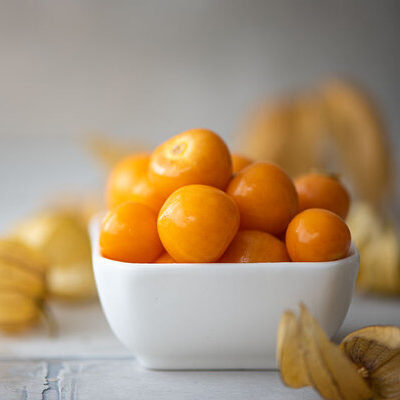
Inca Berry
What is Inca Berry?
Inca berry is the fruit of the Inca berry plant, which is native to Peru, Columbia, Chile, Brazil, and Ecuador. Its appearance is similar to that of gooseberries with a hard, bright amber shell, and a soft bright yellow color on the inside. It is also known as:
- Cape gooseberry
- Aztec berry
- golden berry
- giant ground cherry
- physalis
Inca berries taste mildly sweet, with hints of sourness and a crunchy texture due to their seeds. This unique intermingling of tastes has earned them the comparison of a “healthy sour skittle”.
Some common ways to use Inca berries include:
- Baked goods
- Stuffings
- Salads
- Curries
- Granola or cereal topping
Origin of Inca berries
As the name indicates, these berries are of South American origin, believed to be the lost planet of the Incas. However, it is unclear whether they are wild ancestral plants or cultivated plants that have become wild over time. Legend has it that Incan messengers ran long distances and ate Inca berries on the way to keep their strength up. In countries like Ecuador, Peru, and Columbia, where Inca berries grow in profusion, the plant was often considered a weed until recently, when farmers started to export the fruits.
Nutrition
Inca berries offer significant nutritional value. A 100g serving contains:

Although they are high-calorie food, Inca berries also provide protein, fat, fiber, calcium, vitamin C, phosphorus, and potassium. Inca berries are rich in antioxidants and bioflavonoids and have anti-inflammatory and anti-cancer properties. The fruit also has Secretory IgA, a plant antibody that helps in maintaining the immune system. Furthermore, the berries carry pectin, which is useful for keeping cholesterol in check.
Commercial production
Inca berries are still mostly produced in their native countries. They were introduced to South Africa in the 19th century and some commercial production happens there, as well. They also grow in Australia, the Philippines, and some Pacific Islands. Inca berries are a summer plant, producing fruit throughout the season. They require well-drained soil, although they can also grow in less fertile soil.
There are some ethical issues around the production of Inca berries in South American countries like Ecuador, where farmers’ payments arrive late, pushing the farmers into debt. The farmers also lack resources and knowledge to meet minimum organic requirements. This leads to their exploitation and limits their capacity to negotiate terms.
Inca berry recipes
These berries can be used in sweet and savory dishes. Here are a few recipes with Inca berries:
- Coconut and Inca Berry Brownies
- Berry Jam
- Golden Berries Salsa Amarillo
- Nutty Quinoa with Inca Berries
- Broccolini and Berry Salad
- Raw Physalis Cheesecake
- Curried Onion Stew
FDA Regulation
At this time, the Food & Drug Administration does not have any regulations on this fruit.
References
Grace McCloud, A-Z of healthy ingredients: what are Incan berries and how can I eat them?, Evening Standard, https://www.standard.co.uk/lifestyle/foodanddrink/a-z-of-healthy-ingredients-what-are-incan-berries-and-how-can-i-eat-them-10242274.html
Renée Beune, Dr. Elisabet Rasch, The Inca Berry and los Uvilleros, Wageningen University & Research Centre, International Development Studies, Sociology of Development and Change, http://edepot.wur.nl/394045
Plant of the Week: Physalis peruviana; Cape Gooseberry; Golden Berry, Inca Berry University of Arkansas, Division of Agriculture, https://www.uaex.edu/yard-garden/resource-library/plant-week/Physalis-peruviana-Cape-Gooseberry-Golden-Berry-Inca-Berry-01-12-2018.aspx
